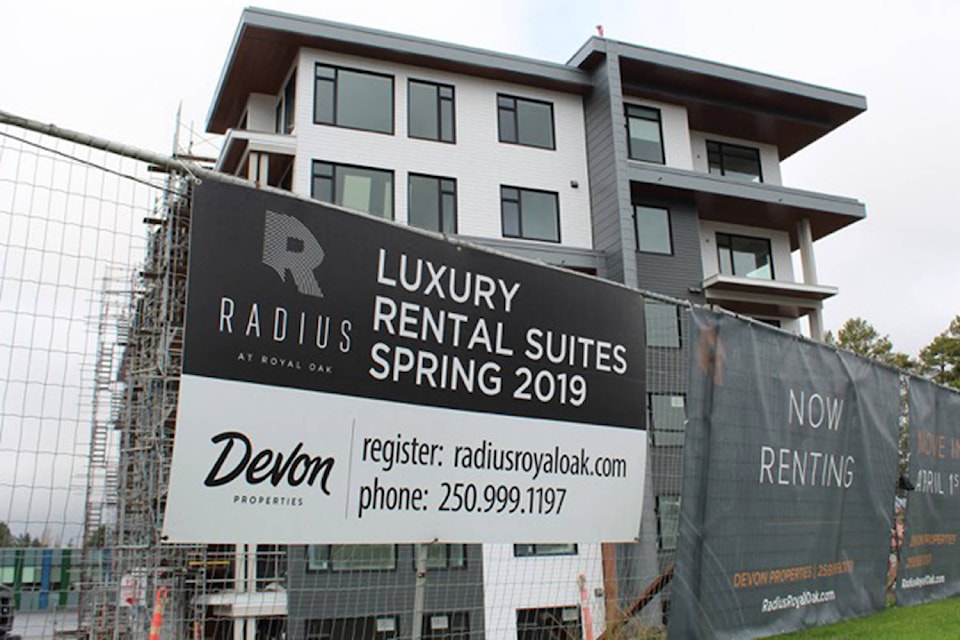First, the good news. Rental vacancies in Greater Victoria are rising. But here is the bad news — so are rents.
Those are the findings of the 2018 Canada Mortgage and Housing Corporation (CMHC) Rental Market Survey (RMS) for Metro Victoria.
The report finds that the 2018 vacancy rate for Greater Victoria stood at 1.2 per cent in October, up from 0.7 per cent in October 2017. But the increase in available units did not impact their rent. Despite the rising vacancy rate, rents rose to $1,406 in October compared to $1,288 in October 2017 — an increase of 7.5 per cent on top of the 7.7 per cent increase in 2017 – the largest increase since 1991.
Senior analyst Braden Batch said the rent increase, while counter-intuitive, could have been higher, had it not been for various forms of rent control.
In assessing the state of the rental market, economists look to the inflation rate, which stood at 2.4 per cent in October — well below the regional rent increases.
RELATED: Students struggling with Greater Victoria’s tight housing market
“That means you have a tight rental market,” he said. No natural vacancy rate exists, said Batch, who expects that the vacancy rate will hit 1.5 per cent in 2019, as new units continue come online. But so will rents, he adds.
The report notes that the region has experienced a multi-year shift in housing demand from home ownership towards rental.
“During this time, the purpose-built rental universe has been slow to respond, leading to several years of under-supply relative to demand, and a low vacancy rate as a consequence,” it reads. “Starting in 2015, however, purpose-built rental starts rose to the equivalent to a [three per cent] share of the existing purpose-built universe, and have since risen to [six per cent] in 2017, and another [six per cent up] to October 2018.”
Batch said this increase in the supply of rental housing has been able to absorb — at least partially — the rising demand for rental housing — hence the rise in the vacancy rate. But he also cautions that the rise in vacancies reflects growing supply on the higher end of the rent range.
Overall, the region has 25,537 rental units, with 17,182 — more than 67 per cent of the total — located in the City of Victoria. It is also the municipality with the lowest regional vacancy rate. Its James Bay neighbourhood recorded a vacancy rate of 0.5 per cent. Victoria’s Cook Street and Fort Street areas recorded vacancy rates of 0.9 and 1.1. per cent each. The rest of the municipality recorded a rate of 1.7 per cent for a total of 1.1 per cent. This said, Victoria also recorded the largest increase in the rental supply, with the largest concentration in the area that includes downtown Victoria.
RELATED: Shelter me: Rental housing crunch plaguing Vancouver Island
Saanich — the region’s largest municipality — recorded a vacancy rate of one per cent — up from 0.7 per cent. (The report lumps together Saanich with Central Saanich and finds that the overall supply of rental housing has gone up by 22 units to 3,122).
Coun. Judy Brownoff said Saanich’s higher vacancy rate and rental stock represents good news for renters, because it means more selection.
Citing a number of upcoming development, Brownoff expects vacancies to increase. “Municipalities now have ability to look at sites for pre-zoning for rentals,” she said. “Saanich planning is looking at that.”
Coun. Zac de Vries offers a more cautious interpretation. “Vacancy is not up very significantly and has actually decreased for some housing types (like bachelors),” he said. “Rents are up, but they are slowing down. There’s work to be done to get Saanich towards a healthy vacancy rate of about four per cent. Supply is needed to address demand while raising the vacancy rate.”
Oak Bay recorded the highest vacancy rate with 2.2 per cent with the provision that Oak Bay has a small stock of rental units (1,046) on the pricier side, said Batch.
The West Shore communities, meanwhile, recorded a drop in vacancies to 0.7 per cent from 1.3 per cent despite the largest proportional increase in the rental housing supply.
Sidney, which recorded a vacancy rate of zero in October 2017, ticked up to 0.8 per cent.
Provincially, the vacancy rate remained low despite a slight increase to 1.4 per cent, compared to 1.3 per cent in 2017. Nationally, the demand for rental housing grew more than supply, with the national vacancy rate dipping to 2.4 per cent from three per cent.
Like us on Facebook and follow us on Twitter
wolfgang.depner@saanichnews.com
